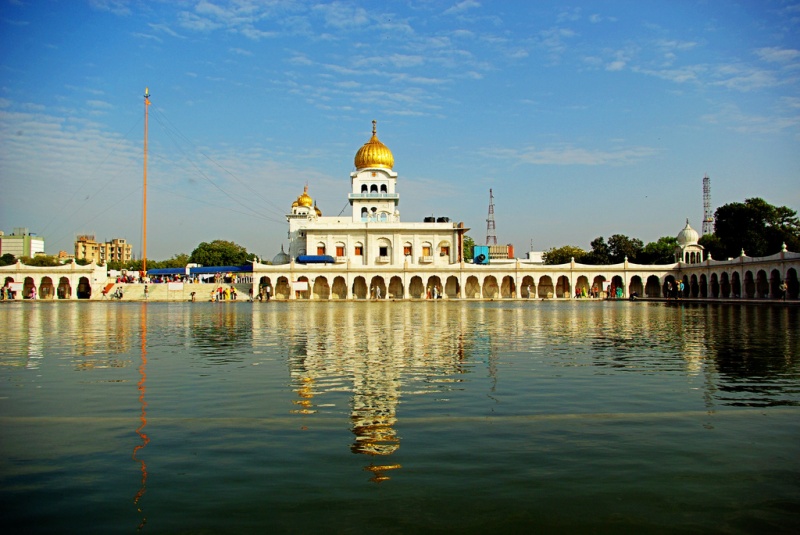When going to do Darshan of Satguru Jee. First one must do Panee da Ishaan (Physical Ishaan) then do BaNee da Ishaan (Spritually Ishaan). This way our yatra is Safal (Fruitful).
Bhai Joginder Singh "Talwara" (Sri Japjee Sahib Viaakhaa)Amritsar SarovarSri Guru Arjan Dev Ji got Sri Harimandir Sahib built in the midst of the sarovar (tank) at the lowest level. Unlike other temples where the devotees have to climb up to offer their obeisance, here the devotees have to step down to offer their homage. This unique temple of God has been built at the lowest level because it represents the humility of Guru Nanak. Humility Incarnate Guru Arjan selected the lowest level because this was to be the eternal seat of the Prophet of Humility, Sri Guru Nanak Sahib Jee(manifest Sri Guru Granth Sahib Jee).
Bibeksar SarovarThe sarovar was built by Guru Hargobind Sahibin in 1628, and the beautiful gurdwara was built by Raja Ranjit Singh 1833. The two ancient villages of Chatiwind and Sultanwind borders the gurdwara.
Nearby was also a beautiful garden where Guru Jee used to come for recreation. He usually took rest on the edge of the tank where now stands the Gurdwara Bibeksar. Sometimes, he held his meetings here in the evening. Here Guru Jee organized his followers on military lines following skirmishes with the Mughal forces.
Situated near Chattiwind gate it also marks the place where Guru Hargobind Sahib used to tie his horse with Kareer Tree; this tree can still be see on the parkarma of the Sarovar.
AKJ hold a Rainsbai Keertan program at the historical Gurdwara Bibeksar Sahib. on last saturday of each month
Kaulsar SarovarOn the west-side of Gurdwara Baba Atal in Amritsar, Punjab lies, a Sarovar (pool) known as Kaulsar Sahib or Kaulsar Sarvor, named after a holy muslim lady called Bibi Kaulan, the daughter of Qazi of Lahore. She was a highly spiritual women who was above religious divides and took refuge with the sixth master Guru Hargobind Ji at Amritsar (1606-1645). The samadh of this lady, who is called Mata Kaulan lies at the western end of the Kaulsar Gurdwara.
The significance of Gurdwara Mata Kaulan and Kaulsar sarovar could be adjudged from the fact that Guru Hargobind, the sixth Sikh guru, had directed the devotees to take dip in Kaulsar before the Golden Temple sarovar.(sakhi to this effect is written right outside the entrance of Gurdwara Bibi Kaulan, adjacent to Darbar Sahib).
Mata Kaulan, against whom qazi had pronounced death sentence for showing devotion to Sikh gurus, was brought here discreetly by Sain Mian Mir who had laid the foundation stone of the Golden Temple. Mata Kaulan, who was allotted a special place near the Golden Temple and Baba Atal, spent her entire life there before breathing her last at Kartarpur.
Santokhsar SarovarWhen (Guru) Ram Das, had not yet ascended to the gaddi, he came here to find out a place for excavation of the holy tank on instructions from Guru Amar Das. When (Guru) Ram Das was getting the place dug, he found a Yogi, meditating. After sometime the Yogi opened his eyes and told Guru Ram Das that he had been meditating here for a long time, waiting for a Guru to give him salvation. He disclosed his name as Santakha and then breathed his last. The tank was then named as Santokhsar. Guru Arjan completed the unfinished work of excavation of tanks - Santokhsar and Amritsar. Baba Buddha was appointed to supervise the work of construction. Santokhsar was completed in 1587-89.
Ramsar SarovarGurudwara Ramsar stands on the bank of the Ramsar sarovar, near Chativind Gate, on the southeastern side of the walled city. After the completion of the Harimandar, Guru Arjan Dev Jee undertook the compilation of Adi Granth, the Holy Book, now revered as Siri Guru Granth Sahib Jee. For this task, he chose a se-cluded site. The spot selected was then a shady nook, one km away from the bustle of the town. To make the surroundings more agreeable, he had a tank dug which was named Ramsar after Guru Ram Das Jee. Here, Guru Arjan Dev Jee composed his famous Sukhmani Sahib, the Psalm of Peace, and with Bhai Gurdas Jee as his scribe compiled the Adi Granth Jee during 1603-04. The present Gurdwara Ramsar, a small marble-lined hall topped by a gilded, fluted lotus dome built in 1855, marks the site of the Guru's labours.
[
www.sikhiwiki.org]

 ਸਤਿਗੁਰਬਚਨਕਮਾਵਣੇਸਚਾਏਹੁਵੀਚਾਰੁ॥
ਸਤਿਗੁਰਬਚਨਕਮਾਵਣੇਸਚਾਏਹੁਵੀਚਾਰੁ॥

 ਸਤਿਗੁਰਬਚਨਕਮਾਵਣੇਸਚਾਏਹੁਵੀਚਾਰੁ॥
ਸਤਿਗੁਰਬਚਨਕਮਾਵਣੇਸਚਾਏਹੁਵੀਚਾਰੁ॥

